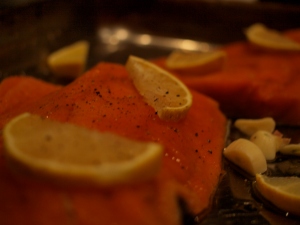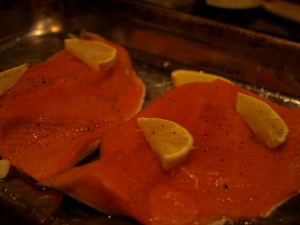There are many good reasons why you should eat wild salmon instead of farmed salmon, and a few good reasons why you probably don’t (I’ll get to those in a minute). In case this isn’t something that keeps you up at night reading internet blogs about sustainable fish, here’s a rundown of some of the issues:
 1) Wild salmon (which, by the way, is almost always from the Pacific side of the world, including Alaskan, Columbia River, Copper River, king or chinook, silver, and sockeye) are generally higher in healthy omega-3 fatty acids than farmed.
1) Wild salmon (which, by the way, is almost always from the Pacific side of the world, including Alaskan, Columbia River, Copper River, king or chinook, silver, and sockeye) are generally higher in healthy omega-3 fatty acids than farmed.
2) Wild salmon are significantly lower in contaminants (things like PCBs, heavy metals such as mercury, and dyes) than their farmed brethren. While the health benefits of eating any salmon (wild or farmed) may outweigh the risks from contaminants (debatable), this is not necessarily the case if you’re pregnant, nursing, or a small child.
3) Eating wild Pacific salmon helps keep the market for sustainably fished salmon strong and protects fish populations. Since wild Atlantic salmon (a different species than Pacific) have been overfished to the point of becoming Endangered, almost all Atlantic salmon for sale in stores or restaurants is now farmed (this includes Norwegian salmon, Scottish, etc., although there are Atlantic salmon fish farms all over the world, including in the Pacific).
4) Wild salmon lead a truly amazing life — you know, spawning in a river then traveling to the ocean and then swimming sometimes hundreds of miles back upstream. All that swimming and living (and eating) in a variety of environments makes the fish magnificent pictures of health and robustness. Obviously not happening on a fish farm.
5) Most conventional fish farms are pretty awful in terms of overcrowding, disease, and contamination. The fish live in nets about the size of a football field and are fed a diet of pellets made from fish byproducts (eww), grains, and dye to make them the pretty pink color we consumers expect them to be; this is the color they’d naturally turn if they were eating their natural diet of crustaceans and whatnot instead of the above-listed pellets (farmed salmon are actually a very unappetizing dull gray).
5) Because the fish farms are so crowded (and I imagine lousy places to live if you’re a fish whose natural instinct is to swim hundreds of miles), many fish escape into the wild, which seems okay but it’s not. These escapees disrupt the spawning habits of the wild fish and have overrun wild salmon habitats; this competition puts even more pressure on wild fish to survive.
6) The fish farms also spread disease and parasites to the wild-salmon habitat.
Okay then, those are the reasons why wild fish are a better choice. But as I mentioned, there are perfectly reasonable reasons why we all don’t “vote with our dollars” and make unsustainable fish farming a thing of the past. Here, in a nutshell, is the rub:
Wild salmon cost about three times more than farmed, are available fresh only during the summer and fall, and definitely don’t always have that uniformly sumptuous, creamy-rich taste that farmed Atlantic salmon are known for. I was at a dinner party a few weeks ago where the host served a behemoth salmon fillet, which was fresh (in January) so obviously farm raised. It was delicious, and she was able to feed 10 people (adults and kids) for, oh I’m guessing, probably about 20 bucks. Whereas, wild salmon would have cost easily three times that much, plus it would have been frozen, and it might have been a little dry…
So, I get why we haven’t all eaten our last bite of farmed Atlantic salmon.
What I suggest is to treat salmon like meat. Eat it occasionally and, since it costs about $20 a pound, don’t screw it up when you cook it. Another tip is to buy more when it’s fresh, and probably a bit cheaper (especially whenever you see it on special), and freeze it; wrap it really well and it should keep for a few months. Canned salmon is almost always wild, by the way, but of course, it’s in a can.
Wild salmon is less fatty and therefore slightly less moist and rich than farmed. I suggest instead of grilling it, which can dry it out, bake it in the oven. I recently tried this and it was delicious, tender, and very simple to make. Here’s the recipe:
Baked Wild Salmon
Ingredients
1 salmon fillet, cut into serving-size (3-5 oz.) pieces
Lemon slices
Garlic cloves (4-5)
Olive oil
Salt & pepper
Butter
 Preheat the oven to 425. Lightly oil a shallow roasting pan or baking dish and put the fish pieces in skin side down. Drizzle with oil and sprinkle with salt and pepper. Put the lemon slices and garlic cloves on and around the fish (this isn’t crucial to the recipe, but I like the way the lemon and garlic infuse the fish with their scents — and they make your house smell like them instead of fish). Bake for about 10-15 minutes until the flesh doesn’t look raw. It will be still pink and should be slightly underdone when you take it out of the oven. If some pieces are thinner than others, you can remove them as they get done. As you can see in the photo, my pieces were too large so they didn’t cook evenly; smaller ones work much better. Once it’s out of the oven, let the salmon rest under a tin foil tent for a few minutes. While the fish is resting, put a pat or dollop of butter on the fish and let it melt.
Preheat the oven to 425. Lightly oil a shallow roasting pan or baking dish and put the fish pieces in skin side down. Drizzle with oil and sprinkle with salt and pepper. Put the lemon slices and garlic cloves on and around the fish (this isn’t crucial to the recipe, but I like the way the lemon and garlic infuse the fish with their scents — and they make your house smell like them instead of fish). Bake for about 10-15 minutes until the flesh doesn’t look raw. It will be still pink and should be slightly underdone when you take it out of the oven. If some pieces are thinner than others, you can remove them as they get done. As you can see in the photo, my pieces were too large so they didn’t cook evenly; smaller ones work much better. Once it’s out of the oven, let the salmon rest under a tin foil tent for a few minutes. While the fish is resting, put a pat or dollop of butter on the fish and let it melt.


Just chose wild over farmed last night…after reading your post. It certainly is a bit denser. Next time i’ll try your recipe. H
Hey, good choice! I agree it does take some getting used to though… another thing to try is baking the fish in parchment or “en papillote,” which I did the other night. You can do everything the same with the recipes, only put the fish, oil, lemons, etc. inside the parchment wrappings (individual). It might take a bit longer to bake, like 20 mins. but will definitely be moist and steamy when it comes out of the oven.